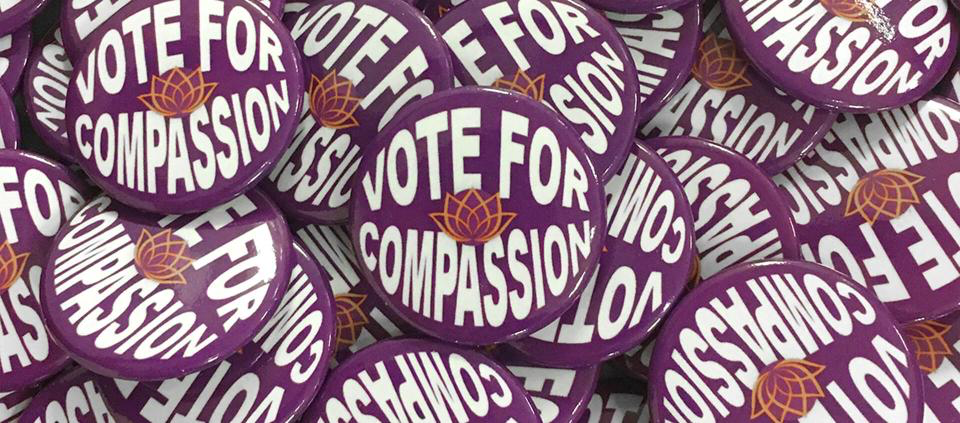How yogic principles compel to engage
Developing a political attitude that’s less divisive and more mindful
United in diversity*
Unstoppable movement is twirling through themes such as climate change and current political affairs in Austria, that deeply affect us. It is a time of change that concerns all of us.
„Change is coming, if you like it or not.” Greta Thunberg
It may be uncomfortable and it may be unprofitable. But change is coming. The change is not only happening in politics, society, economics and the environment, this change first and foremost is happening inside each and every one of us and at the best of times „stirs us crazy“. We can all feel it.
„In order to change your life on the outside, you must first change on the inside.“ Louise Hay
For me, this is when yoga starts to come in and where yoga is deeply connected to politics. From its root base meaning of connection to the yoga of karma (action and reaction), dharma (life’s purpose) and ahimsa (non-violence), to pick just a few, ancient tools were gratefully given to and laid out in front of us to find harmony within and from that place create harmony outside to bring us and the universe back into balance especially for times as they are right now. You say: “Ha, little me has the possibility to change the universe?” Indeed you do! Look at Greta, who started sitting alone in front of the Swedish Parliament, only 15 years old and has now millions of followers all over the world. One individual’s conscious action and compassion and non-wavering action has become a global movement. My favorite vegan organic restaurant in Bali, „Earth Cafe,” has this sign next to its entrance door:
“Never doubt that a small group of thoughtful, committed citizens can change the world; indeed, it’s the only thing that ever has.” Margaret Mead
YOGA MEANS CONNECTION
The word yoga comes from the ancient Sanskrit word „jog”, which literally translates into union. Its deep ancient root is based on the premises that ALL living creatures including all aspects of nature and the universe, are intimately connected. Yoga goes even deeper saying that our true individual essence (atman) is absolutely the same in everyone and everything, just like the shell you pick up on the beach has the same spiral as in your ear, that same „spanda“ (universal base energy waves of creation) is pulsating through all. Every thought you think, word you say, music you listen to and relationship you have. It doesn’t matter what color your skin, whether you are part of the LGBTQIA+ community or belong to the heteronormative society, it surely doesn’t matter what culture you are defined by, if you are a man or a woman, because not only are we all one and the same, but we are intrinsically the same in our essence with the animal kingdom and the nature around us as well.
The entire universe is connected.
If you look at the universe (Brahman) like an ocean, then we are a drop in the ocean; however, we are the ocean at the same time, the same essence. The water might flow through a different region or become muddy, polluted, ice or rain, but the essence is always the same.
“You are not a drop in the ocean. You are the entire ocean in a drop.” Rumi.
Therefore, yoga lays out for us that the root cause of all suffering, war and simple discontent is not realizing that very connection (avdiya) and therefore depression, competition and ego widens into wars, refugee issues and the environmental crisis – to just mention a few.
All this originates in our illusionary sense of separation.
How do we connect? What part does yoga play in this?
Yoga is an internal journey. It is a shift in consciousness. it is not linear and cannot be measured, that is why at times it is more challenging to comprehend. It starts with me. Now.
To get more practical, for me this is where my yoga practice comes. This is a very crucial point, where rolling out the mat, can be the start of huge changes (remember Margret Mead). Our yoga practice takes us again and again back to the mat. We become still, we close our eyes, we focus on our breath, we scan our bodies, we turn all senses inward — we are in the moment. We are out of the rat race, we are not watching TV — we are here, right now. We are aware, we are conscious, we are mindful. Every yoga posture we move into, trains our mind to be still and focused and synchronizes our breath to get calm and feel our essence. That is what we are after in yoga. The aim is not, to look pretty in doing the splits, although it might be a welcome flexible side effect, but it cannot be our focus. We begin to align — with our body, with our breath and with our mind. We find our center and recognize who we really are in our essence and this recognition empowers us to melt into others. We come into balance. This balance has an effect on everything in us and around us. We feel more connected to others and do not want to harm and therefore have a new starting point to approach others.
To be connected doesn’t mean that we can’t be different. To forgive does not mean to agree with someone’s view or action. Different religions, different views, different political parties — but we are able to look beyond the difference and see the „sameness“ in our essence. We focus on our similarities and realize that, basically, we all want the same: love for ourselves and our friends & families, harmony in our surroundings, stability in our home and peace in our country. If we look further we see that the animals and nature also want that, but they don’t have a voice, so it becomes our voice.
Therefore in the next upcoming political discussion with our neighbor, we are more ready to listen to another opinion, we rather prefer to be in harmony than insist our view is the right one, inspiring tolerance in others.
Many yoga postures are called after nature and animals. The division is blurred, when we move into dog or cat or stand up into tree pose. We seek to become the tree, rooted — we seek to become the mountain, majestic and strong. We move into Cobra elegantly but with determination to see open-heartedly what’s beyond. We become the animal. We become nature. The division is gone. And when we step off the mat we feel what they feel, we can feel their suffering, so we want the best for animals and nature, because in realizing what we want for ourselves, we also realize that they just want the same and the only way for ourselves to be content and prospering is when the others are as well.
„The only way to uplift ourselves, is to uplift the lives of others.” Sharon Gannon
YOGA MEANS ACTION
The basic principle of „karma yoga“ is to act — to act selflessly. The Bhagavad Gita (basic Vedic yogic text) lays out in the famous conversation that Krishna tells Arjuna, the warrior, that action is better than non-action because action upholds and preserves the order of the universe.
“Not by abstention from work does a man attain freedom from action; nor by mere renunciation does he attain to his perfection. For no one can remain even a moment without doing work; everyone is made to act helplessly by the impulses born of nature.” Bhagavad Gita, III, 4-5
I feel it is time to act. Too long we have been waiting on the side lines, watching or reading newspapers that instead of bringing us together, focus on tearing us apart, so we are easier to govern. A divided society is easier to control and to mislead for own personal gain. We have been waiting for politicians to implement structures to save the environment. As Greta says: “Nothing has been happening.” It is time to speak up when animals are mistreated, another forest gets cut down for palm-oil or a politician is misusing his power. It is time to join a demo when you believe in something, to write that article, do that radio show, hold that speech. It is time to use less plastic, fly less, buy less. It is time for action to preserve balance. David Attenborough reminds us in the simplest way possible, that the best thing for us to do is:
„Don’t waste, be responsible.“
YOGA IS DHARMA
Yoga teaches us to be responsible just as David Attenborough implies.
The Bhagavad Gita lays out that we are born for a special purpose, our dharma. What is your purpose? What is your special gift? That gift comes with the responsibility to carry it out for your own best good, but above all for the highest common good as our true purpose ultimately is serving others without seeking personal profit. This is where our fulfillment, our contentment — our inner peace lies. Krishna tells Arjuna in the Bhagavad Gita that there is no way he can avoid the obligation of selfless action (see above karma yoga) . Arjunamust act selflessly out of a sense of duty (dharma) He must not work for his own sake , but for the welfare of all.
“You have the right to work, but never to the fruit of work. You should never engage in action for the sake of reward, nor should you long for inaction. Perform work in this world, Arjuna, as a man established within himself—without selfish attachments, and alike in success and defeat. For yoga is perfect evenness of mind”. Bhagavad Gita II.48
Fulfilling our duty, fulfills our purpose while we selflessly serve – that in itself interestingly enough gives us deeper content than an outside source such as a new car, a new job or a new relationship can ever give us. To seek that contentment otherwise, yoga says, is illusion (avdiya).
YOGA IS AHIMSA
As laid out by Patanjali in his Yoga Sutras within the Yamas and Niyamas (our yogic ethic guide of conduct towards others and ourselves) we are asked to live, act and speak our truth (satya) based on ahimsa (non-violence). Mahatma Gandhi was a world leader who governed an entire nation on this principle alone. He steadily carried the book of the Bhagavad Gita with him and famously expressed his love for “the Gita” in these words:
“I find a solace in the Bhagavagītā. When disappointment stares me in the face and all alone I see not one ray of light, I go back to the Bhagavagītā. I find a verse here and a verse there and I immediately begin to smile in the midst of overwhelming tragedies – and my life has been full of external tragedies – and if they have left no visible, no indelible scar on me, I owe it all to the teaching of Bhagavagītā.”
It is our dharma to be just and not harm; it is as simple as that. If it harms another, we harm ourselves, including the environment and the animals.
In my search in connection between Yoga and Politics my conclusion is, that yes yogic principles and spirituality have a well needed space in it for the wellbeing of our global society.
ONE HUMANITY – ONE WORLD Mirabai Ceiba
*fittingly the theme of this year’s lifeball
written by Beate McLatchie

